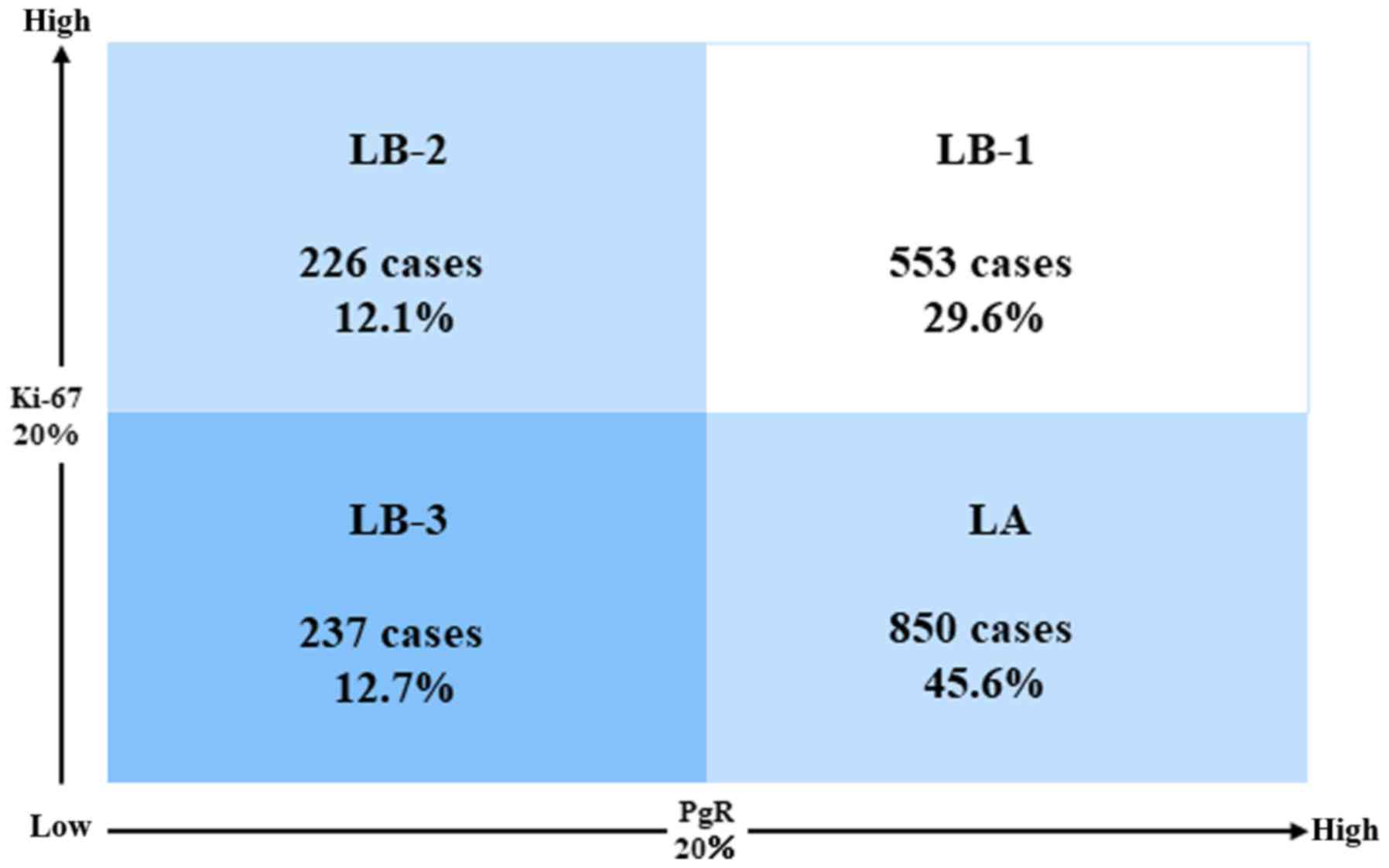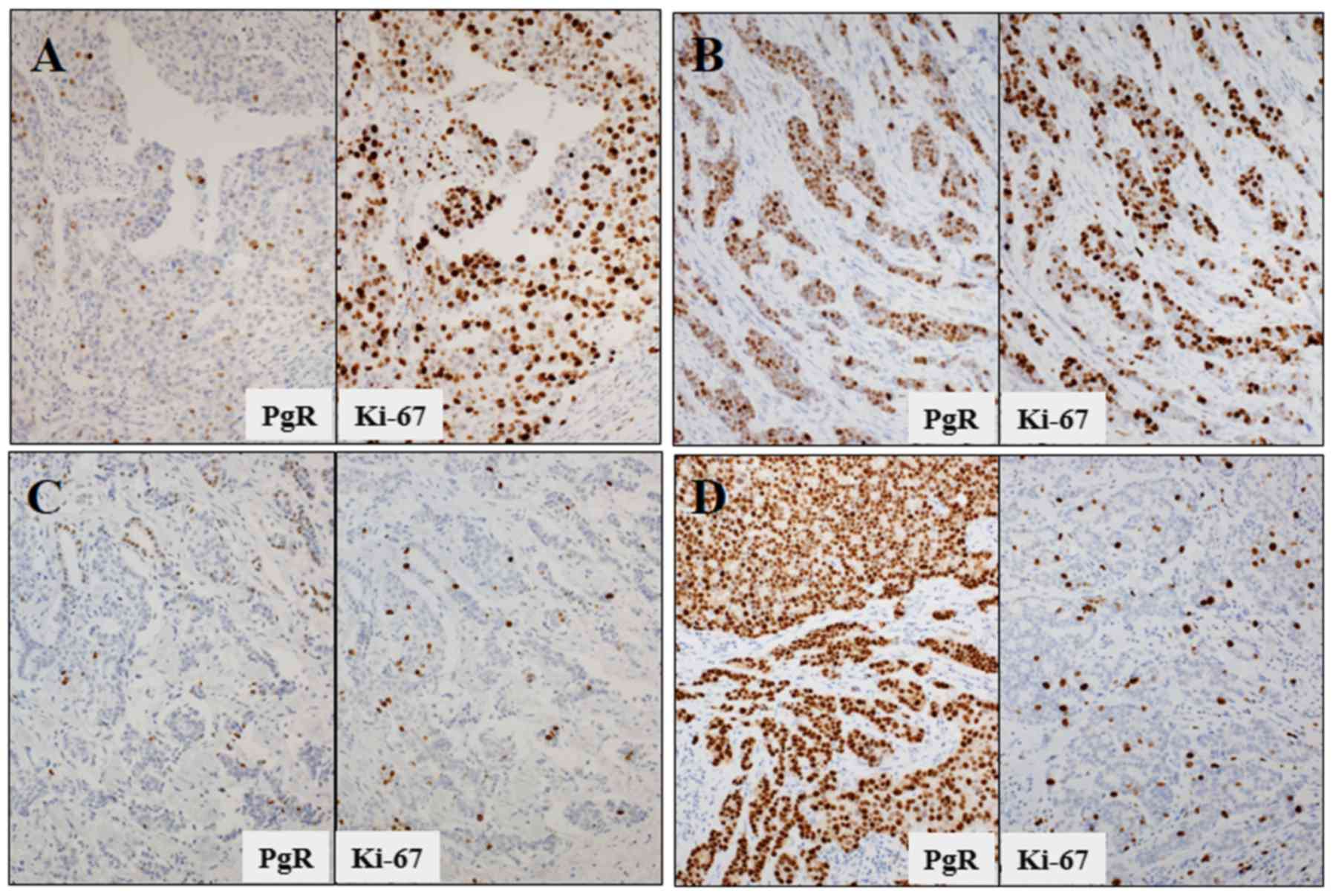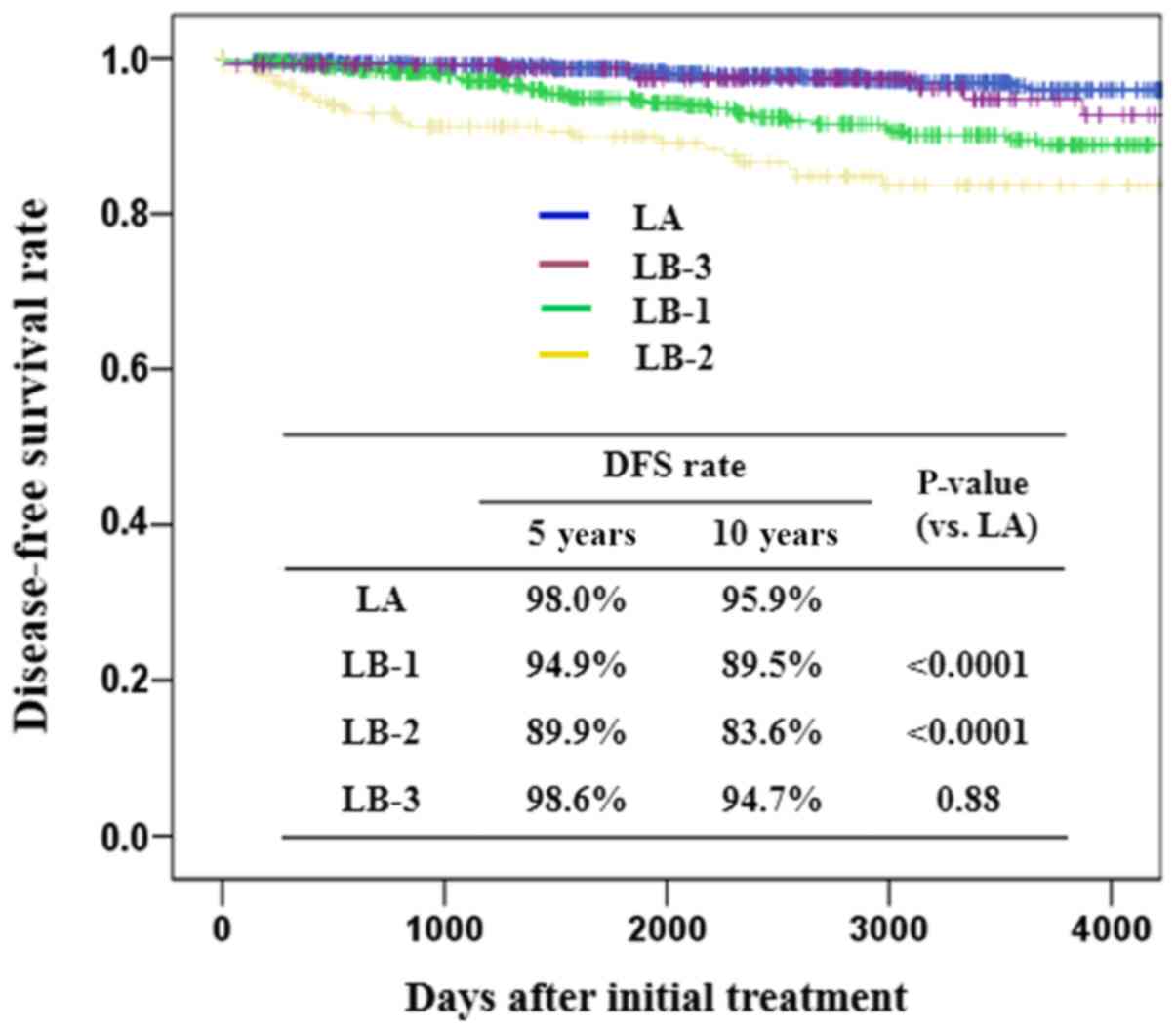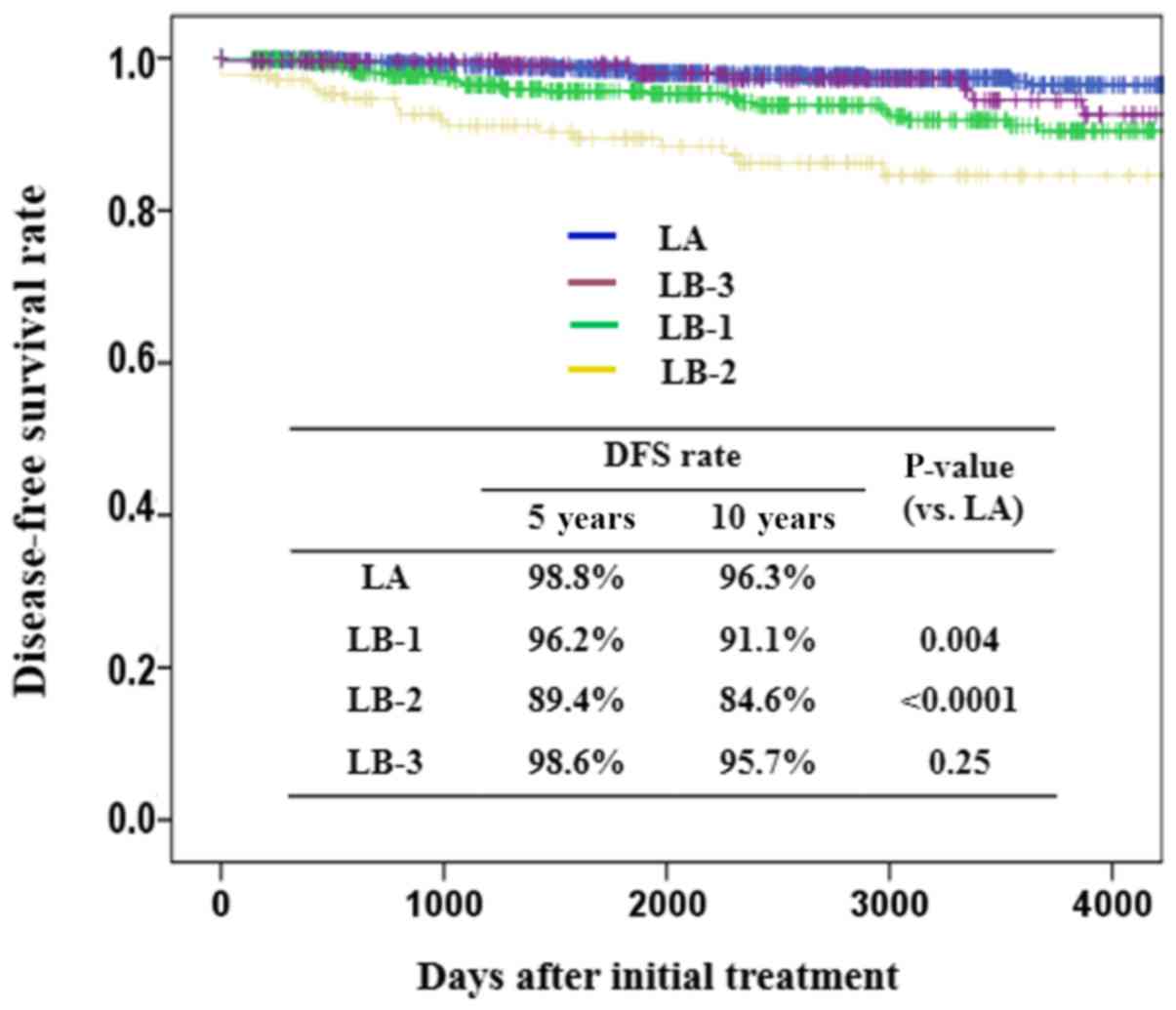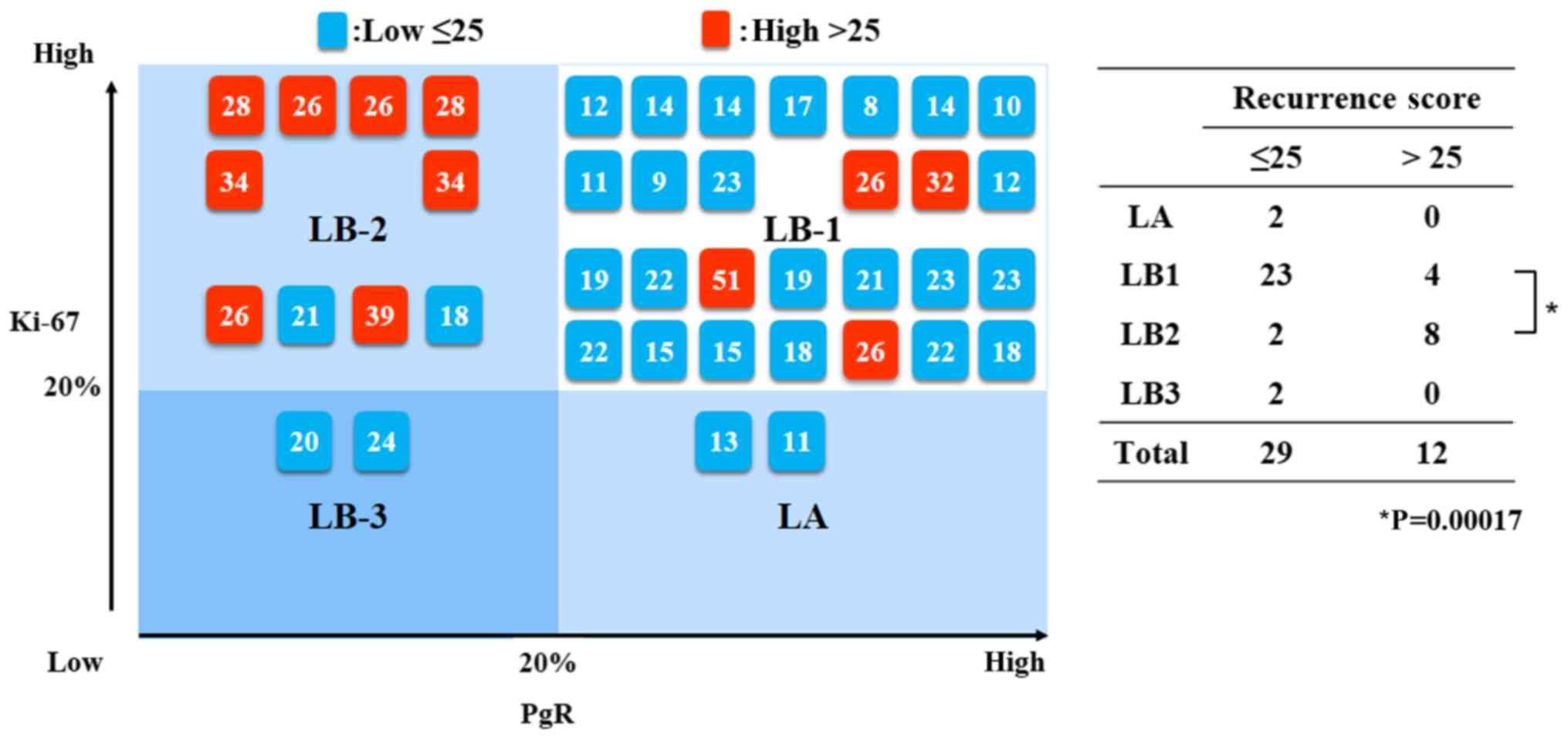Ki‑67 index value and progesterone receptor status can predict prognosis and suitable treatment in node‑negative breast cancer patients with estrogen receptor‑positive and HER2‑negative tumors
- Authors:
- Published online on: October 29, 2018 https://doi.org/10.3892/ol.2018.9633
- Pages: 616-622
Abstract
Introduction
Breast cancer has become a multi-faceted disease with different histopathological and biological features. These biological features are responsible for the distinct behavior often observed in the different kinds of breast cancer and therefore require appropriate therapeutic strategies. Gene profiling has identified 4 breast cancer subtypes [Luminal A, Luminal B, human epidermal growth factor receptor 2 (HER2)-enriched and basal-like] and immunohistochemistry (IHC) is used to determine these breast cancer subtypes. In a previous study, Luminal A was defined as estrogen receptor (ER)- and PgR-positive, HER2-negative, Ki-67 ‘low’ and recurrence risk ‘low’ based on the multi-gene-expression assay (1). A high Ki-67 value (≥20%) and a low PgR value (<20%) are used to separate ‘Luminal A-like’ and ‘Luminal B-like (HER2-negative)’ breast cancers. Previous studies (2,3) found that a higher Ki-67 index value at the hotspot significantly correlated with recurrence and that the optimal cut-off value for Luminal/HER2-negative breast cancer was 20% (4). Moreover, it was reported (5,6) that the proposed IHC-based definition of luminal A tumors is a PgR >20% in hormone receptor (HR)-positive/HER2-negative tumors.
The most common subtype among breast cancer is Luminal A type tumors. In the Carolina Breast Cancer Study (7), luminal type tumors represented 64.3% of all patients and 54.3% of the cases were luminal A tumors. The luminal subtypes generally have a good prognosis but luminal B type tumors tend to have a significantly more unfavorable prognosis than the luminal A subtype (8). Moreover, luminal tumors often respond to endocrine therapy but rarely to conventional chemotherapy (9).
Oncotype DX, also known as the 21-gene assay, evaluates 16 cancer-related genes and 5 normal comparator reference genes and was designed to target ER-positive tumors (10). The purpose of using Oncotype results is to calculate the recurrence score (RS). The higher the RS (scale on a range of 1–100) the worse the prognosis but tumors with a higher RS have a higher probability of responding to chemotherapy (11). Barcenas et al (12) evaluated the recurrence-free and overall survival rates of patients with an RS of 11–25 after receiving chemotherapy. They found similar results in patients (RS of 11–25) with or without chemotherapy in HR-positive, HER2-negative, lymph node-negative breast cancer.
In this study, patients with ER-positive, HER2-negative and negative node were classified into 4 groups according to the PgR and the Ki-67 status (cutoff points, 20%) and retrospectively examined. The analysis was based on the clinicopathological findings and include the RS and disease-free survival (DFS) rates.
Patients and methods
Patients
Invasive breast cancer patients (n=1866) between November 2001 and November 2016 were enrolled in this study. Patient backgrounds are shown in Table I. The cases were classified as follows (Fig. 1); LA (high PgR/low Ki-67; 850 cases), LB-1 (high PgR/high Ki-67; 553 cases), LB-2 (low PgR/high Ki-67; 226 cases), and LB-3 (low PgR/low Ki-67; 237 cases). Out of all these cases, 1,510 were treated with endocrine therapy alone. The median observation period was 78.1 months. Moreover, 41 of the cases underwent a 21-gene expression assay and the RS (≤25 and >25) was compared with our above mentioned classification.
Histopathological examination
The factors investigated were the lymph nodal status, tumor size, nuclear grade, ER/PgR and HER2 status, overexpression of p53 protein and the Ki-67 index value. ER, PgR, HER2, p53 and Ki-67 were evaluated using IHC with an autostainer (Benchmark XT; Ventana Medical Systems, Inc., Tucson, USA) in accordance with the procedure previously reported (13). The antibody used was ER (clone SP1; rabbit monoclonal), PgR (clone 1E2; rabbit monoclonal), HER2 (clone 4B5; rabbit monoclonal; all Ventana Medical Systems, Inc.), p53 (clone DO7; mouse monoclonal) and Ki-67 (clone MIB-1; mouse monoclonal; both Dako; Agilent Technologies, Inc., Santa Clara, CA, USA). The ER- and PgR-positive cell rates were calculated using IHC. The ASCO/CAP guidelines recommend a value of ≥1% stained tumor nuclei as being positive.
The percentage of positive nuclei for Ki-67 was calculated based on a count of at least 500 tumor cells in the hot spot. The p53 overexpression was determined in the cases with positive cells ≥50% (8). Positive for HER2 is either a HER2 score of 3 + (strong and diffuse staining) or FISH amplified in equivocal cases (score 2+). The other staining pattern of HER2 was determined as HER2-negative. Fig. 2 shows the subclassified cases of ER-positive and HER2-negative breast cancer according to the PgR and the Ki-67 status.
Statistical analysis
Statistical analysis was performed using SPSS version 21 (IBM Corp., Armonk, NY, USA). Comparisons between groups (Tables II and III) were analyzed using the Chi-square test and Fisher's exact test. Age was determined using the Student's t-test. Cumulative DFS was calculated using the Kaplan-Meier method and evaluated using the log-rank test.
Table II.The biological classification and clinicopathological characteristics in ER-positive and HER2-negative breast cancer. |
Results
Patient characteristics and biological classification
Table II shows the relationship between the characteristics of the study cohort and the biological classification. The mean age was 58.5 years (range, 25–94). T1 (<2 cm) tumors were often seen in the LA group and rare in the LB-2 group. Nuclear grade 3 and p53 overexpression significantly correlated with LB-2. Endocrine therapy alone was performed in 87.4% (LA), 77.4% (LB-1), 58.8% (LB-2) and 86.9% (LB-3), respectively.
DFS based on the PgR/Ki-67 status in node-negative cases
The Kaplan-Meier curves show the outcomes for DFS according to the PgR/Ki-67 status in the node-negative cases (Fig. 3). There were significant differences in DFS between the LA group (5-year DFS, 98%; 10-year DFS, 95.9%), the LB-2 group (5 years, 89.9%; 10 years, 83.6%; P<0.0001) and the LB-1 group (5 years, 94.9%; 10 years, 89.5%; P<0.0001), but there was no difference in the LB-3 group (5 years, 98.6%; 10 years, 94.7%; P=0.88). In the cases with endocrine therapy alone (Fig. 4), LA and LB-3 had a similar DFS rate (P=0.25). LB-2 had a significantly worse DFS in all cases and in the cases with endocrine therapy alone. Chemotherapy in combination with endocrine therapy was administered to cases with a higher nuclear grade, a larger tumor and p53 overexpression (Table III). In the LB-2 group (Table IV), no difference in DFS was observed between the cases treated with endocrine therapy and the cases treated with chemo-endocrine therapy. However, in the other groups, the cases treated with endocrine therapy had a significantly more favorable DFS than those treated with chemo-endocrine therapy.
Table IV.Comparison of DFS between endocrine therapy alone and chemo-endocrine therapy in terms of PgR/Ki-67 status in the node-negative cases. |
RS using a 21-gene expression assay and biological classification
A relationship was found between the RS derived by using a 21-gene expression assay and biological classification using Ki-67 and PgR expressions (Fig. 5). There were 29 cases with RS ≤25 and 12 cases with RS >25. Moreover, most of the cases with LA (2/2), LB-3 (2/2) and LB-1 (23/27) had a RS of ≤25, and most of the LB-2 (8/10) cases had a RS of >25. There was a significant difference in RS between the LB-1 and LB-2 groups (P=0.00017).
Discussion
The purpose of this study was to investigate the clinical efficacy of a biological classification using the PgR and the Ki-67 status (cutoff points: 20%) so that it could be used as an effective prognostic and predictive classification for determining a suitable postoperative treatment for primary breast cancer with luminal/HER2-negative and negative nodes. Moreover, the above mentioned classification was also compared with the RS derived from the Oncotype DX assay. In this study, it was found that only the LB-2 cases (low PgR/high Ki-67) benefited from chemotherapy.
Luminal A type tumors tend to have a better prognosis, a higher survival rate and a lower recurrence rate among all the breast cancer subtypes and luminal B type tumors tend to have a more unfavorable prognosis (14–17). In this study, all of the Luminal type tumors (1,866 cases) were categorized into the following 4 groups; LA and three LB groups. Luminal A occupied the majority and correlated with a smaller tumor, lower nuclear grade and lower p53 overexpression. On the other hand, nuclear grade 3, larger tumor and p53 overexpression significantly correlated with LB-2. In addition, LB-3 correlated with postmenopausal status, smaller tumor and a lower nuclear grade. These findings indicate that there are biological differences among LB tumors.
In terms of prognosis after initial surgery, significant differences in DFS were observed between the LA group, the LB-2 group and the LB-1 group, but there was no difference in the LB-3 group. In the cases with endocrine therapy alone, LA showed a similar DFS as LB-3. LB-2 had a significantly worse DFS in all of the cases and in the cases with endocrine therapy alone. These findings suggest that the tumors with low Ki-67 values (LA and LB-3) had a favorable DFS irrespective of the PgR status. However, the tumors with a high Ki-67 value but a low PgR expression (LB-2) tended to have a worse DFS rate.
Oncotype DX was originally used in ER-positive tumors and is supported by the ASCO (18) and the NCCN Guidelines (19). The RS result predicts the possibility of obtaining a beneficial effect from chemotherapy and a higher score increases the potential benefit of chemotherapy (20,21). In this study, RS correlated with the biological classification. RS was lower in the LA, LB-1 and LB-3 groups but higher in the LB-2 group. These data suggest that the LB-2 group has a poorer survival rate but benefits from chemotherapy. There was no difference in DFS between the cases with endocrine therapy alone and the cases treated with chemo-endocrine therapy. On the other hand, the LA, LB-1 and LB-3 groups showed a favorable survival rate in the cases treated with endocrine therapy alone. The cases with a high Ki-67 value and low PgR benefited from chemotherapy and this was also predicted in the RS data.
A multivariate analysis revealed that the Ki-67 index was a significant factor for DFS and that the Ki-67 index value was a significant prognostic factor only in luminal type tumors (3,22). Moreover, according to the data from a large cohort clinical study (23), the Ki-67 index value is frequently evaluated in routine clinical work. The Ki-67 expression is an independent prognostic factor for DFS and OS in addition to common histopathological variables and the Ki-67 index independently raises the possibility of predicting the treatment response and prognosis in a group of breast cancer patients who underwent neoadjuvant treatment (24). The Ki-67 index was also found to be an independent predictive factor for pCR (OR 3.5; 95% CI, 1.4, 10.1). The mean Ki-67 value in patients with pCR was 50.6±23.4%, and the average Ki-67 value in non-pCR patients was 26.7±22.9%. In a previous study it was found (25) that ER-positive and PgR-negative/HER2-negative tumors were associated with poorer survival than cases with ER-positive and PgR-positive tumors and had a comparatively poorer survival rate to that of the triple negative breast cancers. Moreover, Prat et al (5) found that the IHC expression of PgR increases the prognostic value within the current IHC-based luminal A definition by improving the identification of favorable breast cancers and the percentage of PgR-positive cells. Moreover, they found that the optimal PgR expression cutoff point to predict outcome was 20%. However, the ER-positive cell rates did not correlate with DFS even after matching for the standard clinicopathologic parameters. A retrospective analysis of three adjuvant clinical trials found that low ER and low PgR expression, and potentially low PgR expression within ER-positive patients were efficacious factors for determining the validity of adding chemotherapy to endocrine therapy (26). These data indicate that the Ki-67 index value and PgR status are important predictors for prognosis and chemotherapy.
In conclusion, the biology, prognosis and suitable treatment for Luminal tumors were evaluated based on the PgR and Ki-67 index value. The patients with a Ki-67 value <20% (LA and LB-3) had a favorable DFS even in the endocrine therapy alone group, whereas those with a Ki-67 value ≥20% (LB-1 and LB-2) had a poorer DFS. Moreover, LB-2 (PgR<20% and Ki-67≥20%) significantly correlated with a higher degree of malignancy but benefited from chemotherapy. The LA and LB-3 cases with low Ki-67 values were considered to be a part of the Luminal A group. These findings suggest that the PgR and Ki-67 status are useful in predicting prognosis and determining the most effective treatment strategy for patients with ER-positive and HER2-negative breast cancer.
Acknowledgements
The authors would like to thank the staff of the Department of Pathology at Kumamoto Shinto General Hospital (Kumamoto, Japan) for their technical assistance and for the collection of cancer tissue samples. The major content of this study was presented at 2017 San Antonio Breast Cancer Symposium (http://cancerres.aacrjournals.org/content/78/4_Supplement/P2-09-32).
Funding
No funding was received.
Availability of data and materials
The datasets used and/or analyzed during the current study are available from the corresponding author on reasonable request.
Authors' contributions
RN and YT conceived and designed the experiments. RN, TO, YN, YO, MN and MF performed the experiments and NA, RN, TO, YN, YO, MN and MF analyzed the data. NA and YT contributed reagents/materials/analysis tools. NA and RN wrote the manuscript.
Ethics approval and consent to participate
The study was approved by the Ethics Committee of Kumamoto Shinto General Hospital (no. 30-J01-001). All patients gave a written informed consent to participate in the study.
Patient consent for publication
Written informed consent was provided for the publication of any data/associated images.
Competing interests
The authors have declared that they have no competing interests.
References
|
Goldhirsch A, Winer EP, Coates AS, Gelber RD, Piccart-Gebhart M, Thürlimann B and Senn HJ; Panel members, . Personalizing the treatment of women with early breast cancer: Highlights of the st gallen international expert consensus on the primary therapy of early breast cancer 2013. Ann Oncol. 24:2206–2223. 2013. View Article : Google Scholar : PubMed/NCBI | |
|
Arima N, Nishimura R, Osako T, Nishiyama Y, Fujisue M, Okumura Y, Nakano M, Tashima R and Toyozumi Y: A Comparison of the hot Spot and the average cancer cell counting methods and the optimal cutoff point of the Ki-67 index for luminal type breast cancer. Oncology. 90:43–50. 2016. View Article : Google Scholar : PubMed/NCBI | |
|
Tashima R, Nishimura R, Osako T, Nishiyama Y, Okumura Y, Nakano M, Fujisue M, Toyozumi Y and Arima N: Evaluation of an optimal cut-off point for the Ki-67 index as a prognostic factor in primary breast cancer: A retrospective study. PLoS One. 10:e01195652015. View Article : Google Scholar : PubMed/NCBI | |
|
Bustreo S, Osella-Abate S, Cassoni P, Donadio M, Airoldi M, Pedani F, Papotti M, Sapino A and Castellano I: Optimal Ki67 cut-off for luminal breast cancer prognostic evaluation: A large case series study with a long-term follow-up. Breast Cancer Res Treat. 157:363–371. 2016. View Article : Google Scholar : PubMed/NCBI | |
|
Prat A, Cheang MC, Martín M, Parker JS, Carrasco E, Caballero R, Tyldesley S, Gelmon K, Bemard PS, Nielsen TO and Perou CM: Prognostic significance of progesterone receptor-positive tumor cells within immunohistochemically defined luminal A breast cancer. J Clin Oncol. 31:203–209. 2013. View Article : Google Scholar : PubMed/NCBI | |
|
Tashima R, Nishimura Y, Arima N, Fujisue M, Nakano M, Okumura Y, Osako T and Toyozumi Y: P260 Evaluation of PgR expression as a prognostic factor in luminal HER2-negative breast cancer. The Breast. 24 Suppl 1:S1162015. View Article : Google Scholar | |
|
O'Brien KM, Cole SR, Tse CK, Perou CM, Carey LA, Foulkes WD, Dressler LG, Geradts J and Millikan RC: Intrinsic breast tumor subtypes, race, and long-term survival in the Carolina breast cancer study. Clin Cancer Res. 16:6100–6110. 2010. View Article : Google Scholar : PubMed/NCBI | |
|
Sorlie T, Tibshirani R, Parker J, Hastie T, Marron JS, Nobel A, Deng S, Johnsen H, Pesich R, Geisler S, et al: Repeated observation of breast tumor subtypes in independent gene expression data sets. Proc Natl Acad Sci USA. 100:8418–8423. 2003. View Article : Google Scholar : PubMed/NCBI | |
|
Brenton JD, Carey LA, Ahmed AA and Caldas C: Molecular classification and molecular forecasting of breast cancer: Ready for clinical application? J Clin Oncol. 23:7350–7360. 2005. View Article : Google Scholar : PubMed/NCBI | |
|
Paik S, Shak S, Tang G, Kim C, Baker J, Cronin M, Baehner FL, Walker MG, Watson D, Park T, et al: A multigene assay to predict recurrence of tamoxifen-treated, node-negative breast cancer. N Engl J Med. 351:2817–2826. 2004. View Article : Google Scholar : PubMed/NCBI | |
|
Gianni L, Zambetti M, Clark K, Baker J, Cronin M, Wu J, Mariani G, Rodriguez J, Carcangiu M, Watson D, et al: Gene expression profiles in paraffin-embedded core biopsy tissue predict response to chemotherapy in women with locally advanced breast cancer. J Clin Oncol. 23:7265–7277. 2005. View Article : Google Scholar : PubMed/NCBI | |
|
Barcenas CH, Raghavendra A, Sinha AK, Syed MP, Hsu L, Patangan MG Jr, Chavez-MacGregor M, Shen Y, Hortobagyi GH, Valero V, et al: Outcomes in patients with early-stage breast cancer who underwent a 21-gene expression assay. Cancer. 123:2422–2431. 2017. View Article : Google Scholar : PubMed/NCBI | |
|
Kai K, Nishimura R, Arima N, Miyayama H and Iwase H: p53 expression status is a significant molecular marker in predicting the time to endocrine therapy failure in recurrent breast cancer: A cohort study. Int J Clin Oncol. 11:426–433. 2006. View Article : Google Scholar : PubMed/NCBI | |
|
Voduc KD, Cheang MC, Tyldesley S, Gelmon K, Nielsen TO and Kennecke H: Breast cancer subtypes and the risk of local and regional relapse. J Clin Oncol. 28:1684–1691. 2010. View Article : Google Scholar : PubMed/NCBI | |
|
Arvold ND, Taghian AG, Niemierko A, Abi Raad RF, Sreedhara M, Nguyen PL, Bellon JR, Wong JS, Smith BL and Harris JR: Age, breast cancer subtype approximation, and local recurrence after breast-conserving therapy. J Clin Oncol. 29:3885–3891. 2011. View Article : Google Scholar : PubMed/NCBI | |
|
Metzger-Filho O, Sun Z, Viale G, Price KN, Crivellari D, Snyder RD, Gelber RD, Castiglione-Gertsch M, Coates AS, Goldhirsch A and Cardoso F: Patterns of recurrence and outcome according to breast cancer subtypes in lymph node-negative disease: Results from international breast cancer study group trials VIII and IX. J Clin Oncol. 31:3083–3090. 2013. View Article : Google Scholar : PubMed/NCBI | |
|
McGuire A, Lowery AJ, Kell MR, Kerin MJ and Sweeney KJ: Locoregional recurrence following breast cancer surgery in the trastuzumab era: A systematic review by subtype. Ann Surg Oncol. 24:3124–3132. 2017. View Article : Google Scholar : PubMed/NCBI | |
|
Harris L, Fritsche H, Mennel R, Norton L, Ravdin P, Taube S, Somerfield MR, Hayes DF and Bast RC Jr; American Society of Clinical Oncology, . American Society of Clinical Oncology 2007 update of recommendations for the use of tumor markers in breast cancer. J Clin Oncol. 25:5287–5312. 2007. View Article : Google Scholar : PubMed/NCBI | |
|
National Comprehensive Cancer Network (NCCN) guidelines, Breast Cancer Version 2.2011. http://www.nccn.org/professionals/physician_gls/pdf/breast.pdf | |
|
Paik S, Tang G, Shak S, Kim C, Baker J, Kim W, Cronin M, Baehner FL, Watson D, Bryant J, et al: Gene expression and benefit of chemotherapy in women with node-negative, estrogen receptor-positive breast cancer. J Clin Oncol. 24:3726–3734. 2006. View Article : Google Scholar : PubMed/NCBI | |
|
Albain KS, Barlow WE, Shak S, Hortobagyi GN, Livingston RB, Yeh IT, Ravdin P, Bugarini R, Baehner FL, Davidson NE, et al: Prognostic and predictive value of the 21-gene recurrence score assay in postmenopausal women with node-positive, oestrogen-receptor-positive breast cancer on chemotherapy: A retrospective analysis of a randomised trial. Lancet Oncol. 11:55–65. 2010. View Article : Google Scholar : PubMed/NCBI | |
|
Nishimura R, Osako T, Okumura Y, Hayashi M, Toyozumi Y and Arima N: Ki-67 as a prognostic marker according to breast cancer subtype and a predictor of recurrence time in primary breast cancer. Exp Ther Med. 1:747–754. 2010. View Article : Google Scholar : PubMed/NCBI | |
|
Inwald EC, Klinkhammer-Schalke M, Hofstädter F, Zeman F, Koller M, Gerstenhauer M and Ortmann O: Ki-67 is a prognostic parameter in breast cancer patients: Results of a large population-based cohort of a cancer registry. Breast Cancer Res Treat. 139:539–552. 2013. View Article : Google Scholar : PubMed/NCBI | |
|
Fasching PA, Heusinger K, Haeberle L, Niklos M, Hein A, Bayer CM, Rauh C, Schulz-Wendtland R, Bani MR, Schrauder M, et al: Ki67, chemotherapy response, and prognosis in breast cancer patients receiving neoadjuvant treatment. BMC Cancer. 11:4862011. View Article : Google Scholar : PubMed/NCBI | |
|
Bae SY, Kim S, Lee JH, Lee HC, Lee SK, Kil WH, Kim SW, Lee JE and Nam SJ: Poor prognosis of single hormone receptor-positive breast cancer: Similar outcome as triple-negative breast cancer. BMC Cancer. 15:1382015. View Article : Google Scholar : PubMed/NCBI | |
|
Viale G, Regan MM, Maiorano E, Mastropasqua MG, Golouh R, Penin T, Brown RW, Kovács A, Pillay K, Ohlschlegel C, et al: Chemoendocrine compared with endocrine adjuvant therapies for node-negative breast cancer: Predictive value of centrally reviewed expression of estrogen and progesterone receptors-An International Breast Cancer Study Group. J Clin Oncol. 26:1404–1410. 2008. View Article : Google Scholar : PubMed/NCBI |



